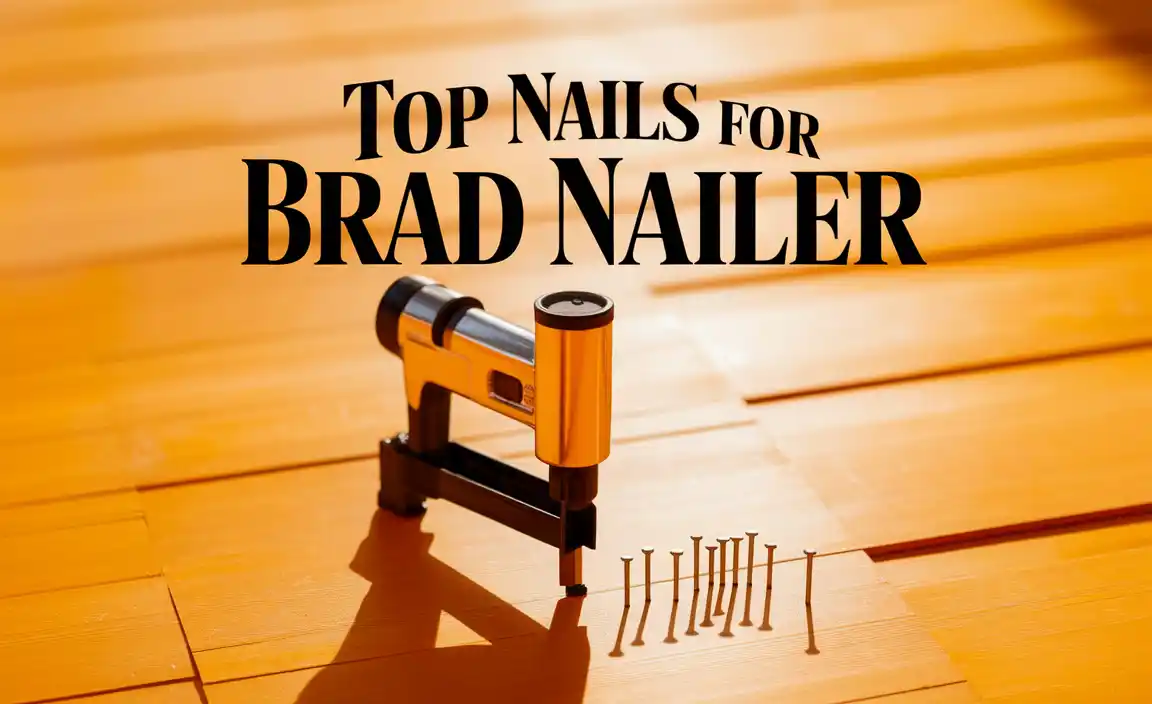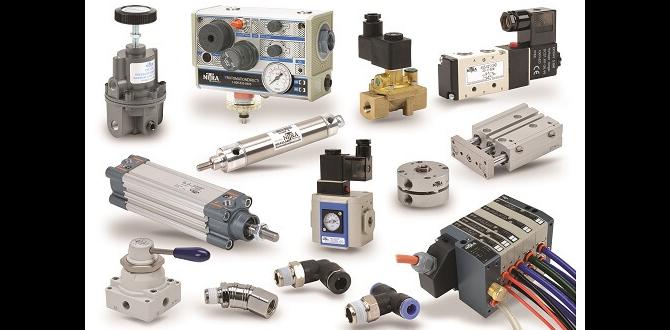Quick Summary: Mastering nail gun safety is crucial for homeowners and hobbyists. Always wear protective gear, understand your tool’s firing mode, keep hands clear, and treat it like a power tool. Following this nail gun safety guide protects you, making your DIY projects successful and enjoyable.
Hey there, fellow DIYers and woodworking fans! Jack Shaffer from Nailerguy here. Ever feel that thrill when you’re about to tackle a new project? Maybe it’s building that deck, crafting a custom shelf, or even just hanging some trim. A nail gun can make these jobs so much faster and cleaner. But, like any powerful tool, it demands respect. The good news is that staying safe isn’t complicated. With a few key practices, you can avoid those “oops” moments and ensure your projects are always a success, not a source of worry.
We’re going to walk through everything you need to know about using a nail gun the smart way. Think of this as your friendly guide to making sure that powerful tool stays on your side. We’ll cover the must-knows, from what to wear to how to handle your nailer on the job. Let’s get those projects done safely and confidently!
Table of Contents
Why Nail Gun Safety is Your Top Priority
Nail guns are amazing tools. They drive nails with incredible speed and precision, saving you time and effort on countless projects. From framing a house to finishing delicate furniture, there’s a nailer for almost every task. However, their power also means potential danger. A misplaced nail or an accidental discharge can lead to serious injuries, impacting your ability to work and enjoy your hobbies. Understanding and practicing proper safety procedures isn’t just a good idea – it’s essential for serious DIYers and hobbyists.
The U.S. Consumer Product Safety Commission (CPSC) reports thousands of injuries related to nail guns each year, with many involving fingers and hands. These injuries can range from minor punctures to severe damage requiring extensive medical treatment. By making safety your number one concern, you protect yourself, your workshop, and anyone around you.
Choosing the Right Nailer for the Job (And Knowing Its Dangers)
Before we dive into safety specifics, it’s good to remember that different nail guns have different uses and, therefore, different safety considerations. Knowing your tool is the first step to using it safely. For example, framing nailers are built for power and speed on rough construction, while finish nailers are designed for more delicate work. Each has its own quirks to be aware of.
Understanding your nailer’s specifications, like the type of nails it fires, its power source (electric, pneumatic, or cordless), and its trigger mechanism, is key to safe operation. A little research into your specific model will go a long way. You can often find detailed safety information in the manufacturer’s manual, which is a crucial document to keep handy.
Essential Nail Gun Safety Gear: Your First Line of Defense
Think of your safety gear as your personal armor. It’s there to protect you from the most common hazards. Investing in good quality gear is one of the smartest decisions you can make for your DIY journey.
Eye Protection: Non-Negotiable
This is absolutely number one. Always, always wear safety glasses or goggles. Even a small piece of flying debris, a nail fragment, or wood splinter can cause permanent eye damage. Make sure your eye protection meets established safety standards (like ANSI Z87.1 in the U.S.). Goggles offer a bit more protection against dust and flying particles than simple safety glasses. Consider a full-face shield for added protection when working with particularly tough materials or when there’s a higher risk of debris.
Hearing Protection: Save Your Ears
Nail guns can be loud! Repeated exposure to loud noises can lead to temporary or permanent hearing loss. Invest in earplugs or earmuffs. They are lightweight, comfortable, and make a huge difference in protecting your hearing over the long run. This is especially important if you’re working on a project for an extended period or in an enclosed space.
Gloves: For Grip and Protection
While not always mandatory depending on the task, gloves are highly recommended. They improve your grip on the nailer, reducing the chance of it slipping. They also offer a basic layer of protection against minor scrapes and splinters. Look for gloves designed for work, offering durability and grip.
Mastering Firing Modes: Sequential vs. Contact (Bump Fire)
Most modern nail guns come with at least two firing modes, usually selectable by a switch or button on the tool. Understanding these modes is critical to preventing accidental nail discharge.
Sequential Trip (Single Shot): To fire a nail in this mode, you must first press the nose of the nailer against the workpiece (to activate the safety contact element) and then pull the trigger. To fire another nail, you repeat this entire sequence. This mode offers the highest level of control and is ideal for situations where precise nail placement is important, like in finish carpentry or fencing. It significantly reduces the risk of accidental firing.
Contact Trip (Bump Fire): In this mode, you can hold down the trigger and then “bump” the nose of the nailer against the workpiece. Each bump will drive a nail. This mode is much faster for laying down multiple nails quickly, which is why it’s favored in framing and subflooring. However, it also carries a higher risk of accidental discharge if the trigger is held down while moving the tool or if it bumps against something unexpectedly.
Important Note: Always confirm the mode your nailer is set to before operating. Accidentally using bump fire when you intend to use sequential fire can lead to unintended nail placement and potential injury. Many professionals recommend disabling the bump fire mode unless specifically needed for a task. Refer to your tool’s manual for specific instructions on how to select and operate these modes.
Your 10-Step Nail Gun Safety Checklist
Here’s a straightforward checklist to follow every time you pick up your nail gun. Think of it as your pre-flight check for DIY success!
- Read the Manual: Before you even plug in or connect your nailer, read the manufacturer’s manual. Every tool is a little different, and the manual is your best resource for specific safety instructions and operational guidelines.
- Wear Your PPE: As discussed, safety glasses, hearing protection, and appropriate gloves are a must. Make this a habit for every use, no matter how small the task.
- Check Your Nailer: Before each use, inspect your nail gun. Ensure it’s clean, free from damage, and that all parts are securely in place. Check the air hose (if pneumatic) for leaks or kinks.
- Understand the Firing Mode: Confirm your nailer is set to the correct firing mode (sequential or contact). If you’re not sure you need bump fire, set it to sequential for maximum safety.
- Clear Your Workspace: Ensure the area around you is free of clutter, tripping hazards, and other people. Secure any materials you’re working with so they don’t shift unexpectedly.
- Keep Hands and Body Clear: Never place your fingers on or near the trigger while handling the nailer, especially when moving it. Keep your hands and other body parts well away from the intended nail path.
- Never Point the Nailer at Yourself or Others: Treat your nail gun like a firearm in terms of pointing hazards. Never aim it at any part of your body or anyone else, even if it’s not loaded or armed with air.
- Secure the Workpiece: Make sure the material you’re nailing into is stable and won’t move. A secure workpiece prevents unexpected slippage, which can cause the nailer to recoil or the nail to go astray.
- Disconnect Power When Not in Use or When Changing Nails: For pneumatic nailers, disconnect the air hose when you are done using the tool, when clearing jams, or when leaving the work area. For electric or cordless models, disconnect the power source (unplug or remove the battery). This is a critical step to prevent accidental firing.
- Clear Jams Safely: If a nail jams, disconnect the power source immediately. Consult your manual for the correct procedure to clear the jam. Never try to force a jammed nail out.
Your Nailer, Your Responsibility: Safe Handling Practices
Beyond the checklist, there are ongoing practices that build a culture of safety around your nail gun use.
Keep Your Fingers Off the Trigger
This is a big one. Make it a rule: fingers off the trigger unless you are actively and intentionally firing a nail. This is especially important when you are moving from one spot to another or when you are simply holding the tool. The temptation to keep your finger on the trigger, especially when using bump fire, is high but incredibly dangerous.
The “No-Load” Firing Rule
Never ever fire a nail gun when it is not in contact with a workpiece. This is known as “no-load” firing. It’s not only wasteful but also dangerous. The nail can fly off in an unpredictable direction, and repeated no-load firing can damage the tool itself.
Be Mindful of Recoil
Nail guns, especially framing nailers, have noticeable recoil. Be prepared for it. This means maintaining a firm grip and not being surprised when the tool kicks back slightly after driving a nail. Improper handling of recoil can lead to loss of control.
Working with Different Materials
The type of material you’re nailing into can affect how the nail gun behaves. Hardwoods might require more power or specific nail types, and there’s a greater chance of ricochet. Softwoods might allow for easier penetration but could also splinter. Always ensure you have the right nail and nailer for the material.
Securing Your Materials
This goes hand-in-hand with material type. Always clamp or secure your workpiece firmly. This prevents shifting, reduces the risk of the nailer slipping, and ensures the nail goes exactly where you intend it to. A wobbly piece of wood is an accident waiting to happen.
Pneumatic Nailer Specifics: Air Pressure and Hoses
If you’re using a pneumatic (air-powered) nail gun, there are a few extra safety points to consider regarding the air compressor and hose.
Correct Air Pressure is Key
Using the correct air pressure is vital. Too much pressure can cause the nailer to misfire, damage the tool, or drive nails too deeply. Too little pressure won’t drive the nails properly. Check your nailer’s manual for the recommended operating pressure range. Most pneumatic nailers operate between 70-120 PSI (pounds per square inch). Your compressor’s regulator should be set to a pressure within this range, often a bit lower than the maximum recommended to provide a buffer.
You can learn more about PSI and air compressors from resources like OSHA’s standards on air-powered equipment, which provide comprehensive safety guidelines for construction sites that translate well to DIY applications.
Hose Safety
Inspect your air hoses regularly for cuts, abrasions, or weak spots. A burst hose under pressure can be dangerous. Ensure quick-disconnect fittings are properly secured and that the hose is routed away from high-traffic areas and sharp edges. Always release any residual air pressure from the hose and tool when you’re finished or need to disconnect.
Electric and Cordless Nailer Safety
Electric and cordless nailers offer portability and convenience, but they have their own safety considerations.
Battery Management
For cordless models, ensure batteries are properly charged and inserted. Store batteries in a cool, dry place, away from metal objects that could cause a short circuit. Follow the manufacturer’s instructions for charging and maintenance to ensure both safety and longevity.
Cord Management (Electric)
If using an electric nailer, be mindful of the power cord. Avoid running it across walkways where it can be tripped over, or where it might get cut by sharp objects. Ensure the cord is in good condition, with no fraying or damage.
Table: Nail Gun Safety Gear vs. Hazards
This table summarizes the key safety gear and the hazards they protect you from:
| Safety Gear | Primary Hazard Protected Against | Secondary Benefits |
|---|---|---|
| Safety Glasses/Goggles | Flying debris, nail fragments, splinters, accidental nail discharge. | Dust protection. |
| Hearing Protection (Earplugs/Earmuffs) | Noise-induced hearing loss from nail gun operation. | Can help reduce distractions. |
| Work Gloves | Scrapes, splinters, improving grip on the tool. | Protection against minor impacts. |
| Sturdy Footwear | Dropping the tool, stepping on dropped nails or debris. | General workshop safety. |
When to Call a Professional
While DIY is about empowering yourself, there are times when a nail gun might not be the best tool for the job, or when construction itself requires expert hands. If you’re dealing with complex structural framing, unusual materials, or anything that feels beyond your comfort or skill level, it’s always wise to consult a professional carpenter or builder. They have the experience, specialized tools, and knowledge to handle these situations safely and effectively. For advice on when a DIY project might be too ambitious, resources like the This Old House website offer great insights.
Frequently Asked Questions About Nail Gun Safety
Q1: Can a nail gun fire a nail if the safety tip isn’t pressed against the wood?
A: Not if it’s set to sequential firing mode. In sequential mode, you must press the safety tip against the material AND pull the trigger for a nail to fire. However, in contact (bump fire) mode, you can fire nails by holding the trigger down and bumping the tip, which offers less control and higher risk if not handled carefully.
Q2: How do I prevent my nail gun from jamming?
A: Ensure you are using the correct type and size of nails for your specific nail gun. Also, make sure you’re using the correct air pressure (for pneumatics) and that the tool is clean and well-maintained. Avoid firing “no-loads” (when the gun isn’t on a surface) as this can damage the internal mechanism.
Q3: What’s the best way to store my nail gun?
A: Disconnect the power source (air hose, battery, or plug). Clear any remaining nails from the magazine. Store it in a dry, secure place, preferably in its original case or a dedicated tool bag. For pneumatic guns, you might want to add a couple of drops of specialized pneumatic tool oil to the air inlet for maintenance.
Q4: Is it safe to use a nail gun if I’m left-handed?
A: Yes, nail guns are generally ambidextrous in their functionality. The trigger and safety contact mechanisms work the same regardless of which hand is holding the tool. Just ensure you have a firm grip and are comfortable with the tool’s weight and balance. Always keep your non-dominant hand away from the nose and trigger areas.
Q5: How often should I oil my pneumatic nail gun?
A: For pneumatic tools, it’s generally recommended to add 1-2 drops of pneumatic tool oil into the air inlet before each day’s use, or every few hours of continuous operation. Over-oiling can also cause issues like oil sputtering from the exhaust, so follow the manufacturer’s specific recommendations. Electric and cordless nailers typically do not require oiling.
Q6: What if a nail penetrates the material and sticks out? Is it dangerous?
A: Yes, a partially driven or protruding nail is still a hazard. It can be sharp and cause cuts. Always ensure nails are driven flush or slightly below the surface. If a nail is sticking out, disconnect the power source and carefully remove the nail with pliers or use the nail gun itself, set to the correct depth, to drive it in further. Wear your safety glasses and gloves when doing this.
Q7: Are nail guns covered by any safety regulations?
A: Yes, various agencies set standards. In the United States, the Occupational Safety and Health Administration (OSHA) has regulations concerning the safe use of pneumatic tools and specifies guarding and protective equipment requirements. The Consumer Product Safety Commission (CPSC) also tracks injuries and can influence product design and safety standards.
Conclusion: Building Projects Safely, Building Confidence
You’ve got the knowledge, you’ve got the plan. Using a nail gun safely is all about awareness, preparation, and consistent good habits. It’s not about being scared of the tool; it’s about respecting its power and understanding how to channel it effectively for your projects.
By integrating this nail gun safety guide into your routine – from choosing the right gear to understanding firing modes and following every step—you’re not just protecting



